Awesome Buco! Two Braised Pork Shanks Slug it Out
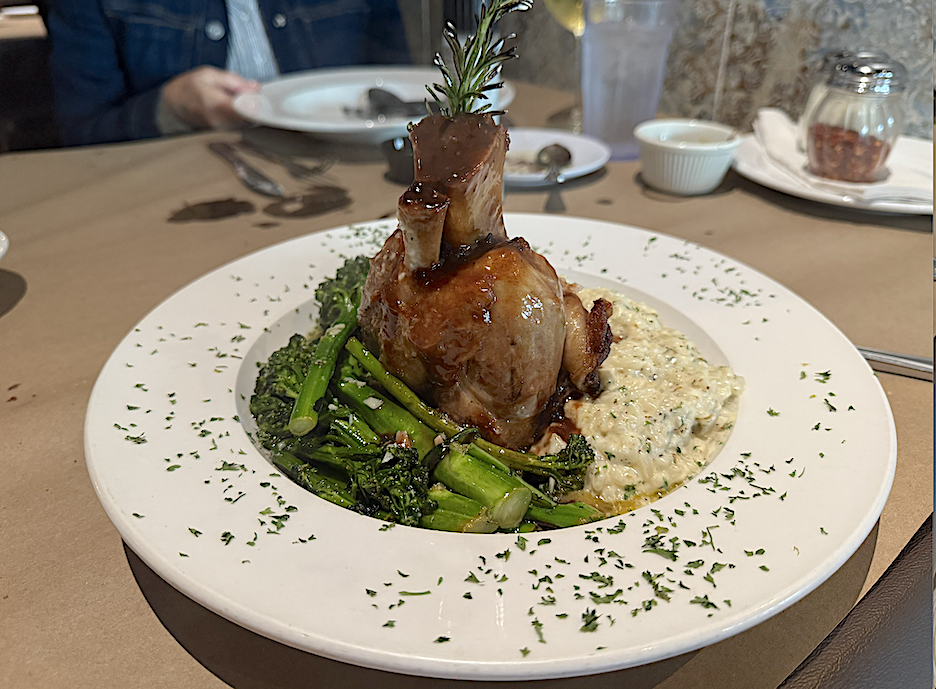
Ossobuco is the culinary embodiment of the proverb “the nearer the bone, the sweeter the meat.” The dish, which dates back to the early 1800s in Northern Italy, centers around a slow-braised meat shank — beef, veal or pork (I’ve only had the latter, as far as I know). Translated from Italian, ossobuco means “bone with a hole.” The meat is definitely bone-adjacent — thus tasty and tender. And sweeter. Two locally owned Italian restaurants square off this week: Buona Ristorante on St. Pete Beach and Gratzzi Italian Grill in downtown St. Pete. BUONA RISTORANTE First, kudos to Buona for resilience. The small space in Dolphin Village was hammered by last year’s hurricanes and underwent a three-month rebuild. Then in mid-May, a large portion of the shopping center — including a CVS and a Publix — burned down. Buona, unaffected by the blaze, closed for a couple of days per the fire marshal, but news reports said the untouched storefronts would be shut down indefinitely. That confluence of events, plus the ongoing construction nearby (as can be seen in the photo) have seriously hampered business. Yet Buona persists and will continue doing so — so said Alison, the manager I spoke to. We arrived at 6:30 Tuesday, and even though Buona has outdoor seating in the front and back, we chose a four-top inside for our party of three. Bonnie and I opted to split the Rosemary Osso Buco ($34) and added a house side salad for five bucks. Appearance In my experience, ossobuco always looks striking, and this version made the grade. The bone jutted upward, with a sprig of rosemary on top. The pork shank was joined by a generous helping of parmigiano risotto and sautéed broccolini. A bonus: the dish arrived with steam wafting upward. Taste and Texture Part of the fun of eating ossobuco is fork-peeling delicate pieces of meat from the bone, and seeing it all fall apart. Even better is eating the sublimely tender morsels. It’d been several years since I’d had the dish, and Buona’s version lived up to my high expectations. The rosemary demi-glace was vividly rich, accentuating the flavor of the pork. I’m not much of a risotto fan, but I enjoyed this cheesy version. The broccolini was crispy to the point that it needed cutting with a knife and fork. A sizable piece of the shank remained, and it’s sitting in my fridge as I write this. GRATZZI ITALIAN GRILL News accounts have noted how difficult this summer has been for Bay area restaurants, with several closing. Gratzzi — open for 15 years, but it seems like longer — is an exception. At 7:15 on a Wednesday, in September, the restaurant was at capacity. Our party of three was fortunate to score a four-top in the quieter dining room, away from the bar, without a wait*. Gratzzi presents as an old-school Italian eatery — as in, dark. With velvet curtains on one side of the room. You get the idea. Our eyes widened a little when we saw that the Pork Ossobuco cost $52. We wondered aloud why Gratzzi charges such a hefty price. “Because they can,” I said. Appearance “Where’s the bone?” I asked with a twinge of panic. After a bit of inspection, we saw that it laid horizontally, buried under braised pork. Phew. This version wasn’t pretty, although it did have a purple flower, which seemed out of place amid a mound of brown. The vegetable medley included carrots, a good sign. Taste and Texture The meat’s texture was firmer than the competition’s, with a slightly bolder flavor. I consulted the menu later and saw that Gratzzi uses “Kurobuta” pork, which, according to the AI machine, refers to a Berkshire breed whose meat is often called the “Wagyu of pork.” The demi-reduction was more like a gravy than Buona’s. And the ample portion soaked the porcini mushroom risotto that sat beneath the meat. (The dish did not taste of mushroom, for which I was grateful.) The soft carrots were a bonus, as expected. And the Winner of the Awesome Buco Battle Is … Gratzzi. This was a close call, and I’d gladly order either one again. The factor that tipped the decision toward Gratzzi was its “gravy.” * A Closing Note: We at first sat down to eat ossobuco at Cafe Cibo, whose pricing is closer to Buona’s. When our server told us that it was no longer on the menu, we got busy on our phones and were relieved to discover that Gratzzi serves it, so we pivoted and hustled downtown. The Gratzzi menu says to “ask for availability,” of ossobuco, so we lucked out. Sometimes field work for Friday Food Fight can be downright harrowing. More from the AI machine: “The nearer the bone, the sweeter the meat” proverbial saying, late 14th century. Usages reflect both the belief that meat close to the bone has the best taste and texture, and the idea that it is valued because it represents the last vestiges of available food. In another search, I turned this up: The final part of something is the most exciting.
Salad Days: The 9 Best I’ve Eaten This Year (So Far)
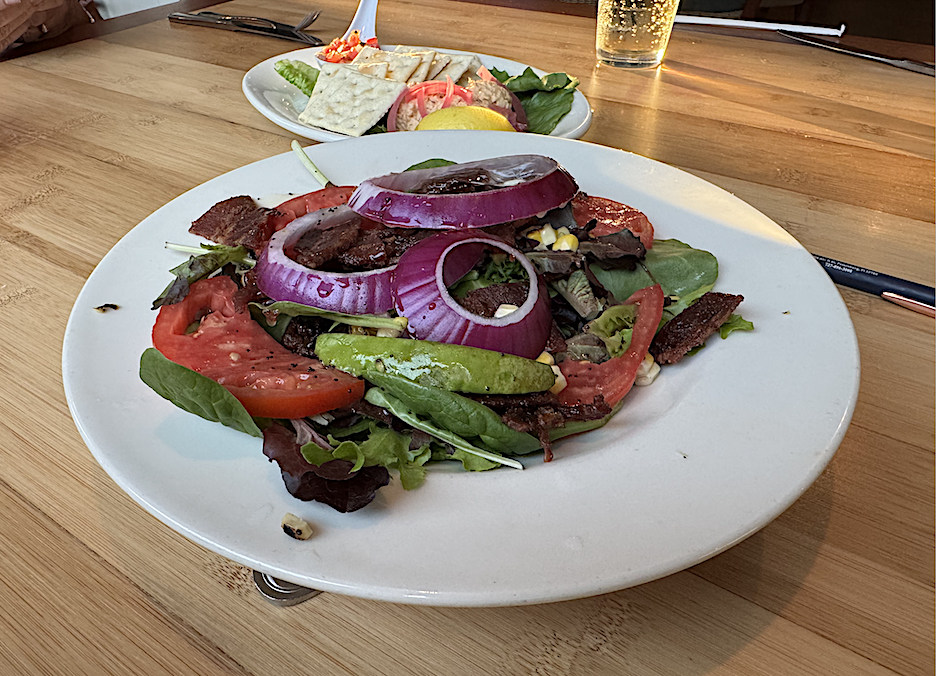
Salads were always something I shoveled in my mouth as a preamble to the real food. Then a few months ago — probably out of food-writer obligation — I started paying more attention, ordering salads that looked interesting on menus, carving out space for them in this column. Yet I never got to the point where I featured two salads in an actual Friday Food Fight. So I went with something better — I think — by putting together a list of the best ones I’ve eaten in ’25. Nine of them made the grade. I’ll reveal my favorite at the end. Cognac Cognac Romaine Salade à la Lyonnaise This French restaurant that opened in downtown St. Pete in February offers a salad with a fancy French name. Its X factor is a poached egg that runs throughout the romaine lettuce and thick pieces of bacon. Hmm, a salad with bacon-and-eggs (dressed in a tangy vinaigrette). Count me in. Tryst Watermelon Burrata Although this place on Beach Drive is more known as a night spot, its food menu includes an impressive grouping of four salads. We chose the Watermelon Burrata and were glad we did. A big bulb of the smooth cheese mixed with golf-ball-sized pieces of watermelon to evoke a sublime fruit-to-salt/crispy-to-creamy blend. It all sat on a bed of arugula, and was finished with salted, roasted pistachios. Fresco’s Waterfront Bistro Fresco’s House Salad Sometimes it’s the little things. The tomatoes in this salad were sliced lengthwise, making them less seedy and amplifying their flavor. Same with the red onion. The carrots were julienned. Pepita seeds provided little morsels of delight. A sesame ginger dressing tied it all together. Rumba Island Grill Rumba Bacon, bacon, candied bacon. You can never have too much bacon — candied or otherwise — although this salad pushed that envelope. The cured meat was joined by thick rounds of red onion, tomato slices that were far better than we tend to get around here, greens and other good stuff (blistered street corn!), coated in a sweetish dressing. In all, a winning combo. Beacon Sample Salad at Tampa Bay Food Fight We ate this wonderful assemblage at the annual food event in Amalie Arena. The small portion served in a paper bowl blended assorted greens, cranberries, grapefruit, a slice of prosciutto and small bulb of burrata. A sweetish dressing topped it off. So good we went back for another round. Unfortunately, the salad does not appear on the regular menu of this rooftop lounge in downtown Tampa. Even so, I had to include it. Teak House Salad I’ve eaten this one twice — and dug it both times. This imaginative array accents its greens with hefty helpings of strawberries and mandarin oranges, which render it altogether refreshing. A “roasted sesame pineapple ginger dressing” adds to the delight. BellaBrava Misticanza A superior house salad of romaine lettuce, radicchio, red onion, little tomatoes and other goodies, liberally topped with grated grana padano cheese. We were all in on the honey basil dressing. Bascom’s Chop House Bascom’s House Salad Iceberg lettuce, yes! Julienned ham and Swiss cheese, nice! Green olives, uh huh. Topped with a tangy parmesan vinaigrette dressing, liberally sprinkled with grated parmesan. A classic steakhouse salad. Sunshine City Tavern The Belle Salad And lastly, a salad with a side of heavy sadness. Sunshine City, the dream concept of celebrated local chef Ted Dorsey, opened in late March on 4th Street in St. Pete. A month later, Dorsey received a diagnosis of Stage 4 pancreatic cancer. Due to his health issues, the restaurant closed in early August. We ate there in April and mightily enjoyed the Belle Salad, which had a cornucopia of flavors: apricots and candied pecans for sweetness, red onions for a touch of bitterness, smoked gouda for sharpness. A lovely Honeycomb Vinaigrette with a subtle flavor of horseradish. We ordered it with chicken tenders, which were moist and flavorful and had a perfect crust. I got to know Ted while he was working on opening The Mill in downtown St. Pete and I was reporting on restaurants for the Tampa Bay Business Journal. We struck up an easy rapport and stayed in touch. He’s a great guy and a fabulous cook. We wish him nothing but love during his cancer battle. My Fave Watermelon Burrata at Tryst. Runner up: The Belle Salad at Sunshine City Tavern.
Spotlight: Ford’s Garage—Beef vs. Bison in a Burger Battle
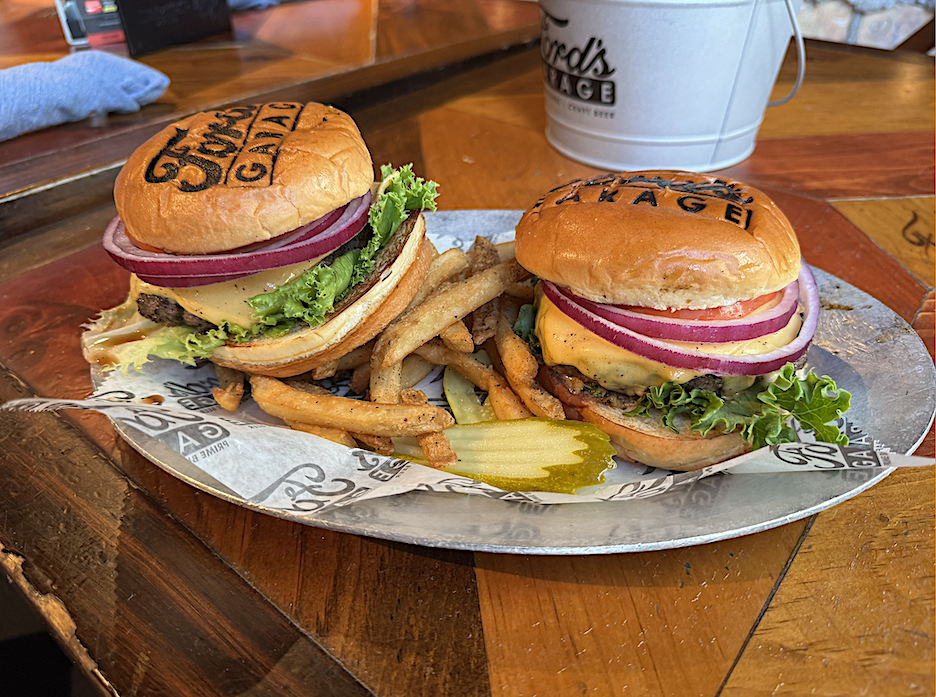
I’ve eaten infinity beef burgers, a smattering of plant-based burgers and zero bison burgers that I’m aware of. Suddenly, I’ve become bison-curious. I chose a different tack for this week’s edition: Rather than square off bison burgers at two restaurants, I chose to pit a bison burger against a beef burger in the same place: Ford’s Garage. We decided to make it a blind taste test. Simple, right? Not for us. And not for the Ford’s Garage service staff. The exercise did make our outing more fun, though. I racked my brain trying to figure out how to do a dramatic reveal between beef and bison in this space, but I guess I’m just not smart enough. I will, however, reveal which one I preferred. FORD’S GARAGE We arrived at the downtown St. Pete location — there are three on the other side of the Bay — at 6:30 Tuesday, and sat inside amid the wild assortment of Ford paraphernalia. Our server, Jared, was game for the blind test. We opted to put basic toppings on each burger: American cheese, lettuce, tomato, onion. (The beef burger cost $14.99, the bison version was $19.98.) Jared explained to the kitchen people and the manager that we should not know which was which. After about 10 minutes, a woman walked towards us with two plates. She presented them with a flourish. “And heeere’s the bison bur…” “No!” I exclaimed. Her name was Tracy, the managing partner, and we had a good laugh about it. Fortunately, I had turned my head away quickly enough to preserve the blindfold test. Appearance I’ve stacked the two photos above so you can play along. Can you determine on a screen which is beef and which is bison? One burger looked fatter and more pink inside. But there was no tell-tale evidence differentiating the two. One dish had fries, the other onion rings, and we hoped that Jared and/or Tracy would remember which was which. Bonnie and I debated how we could best keep track of each burger as we taste-tested, and ultimately found that a third plate helped. Taste and Texture I alternated between burgers, reluctantly setting aside my regular ketchup or other condiments to better taste the meat. Such hardships. We had fun analyzing each burger almost as much as we enjoyed eating them. The fatter one had a meatier flavor, and — if I chewed slowly enough — a more grainy consistency. I could detect in the darker one a more pebbly texture. Neither was noticeably more juicy than the other. Bonnie and I made our beef-or-bison determinations early on, both of us on the same page. As I ate further, the differences between the two began to diminish, and I had pangs of doubt about my choices. The Reckoning While I pause to build suspense, take a moment of have a look at the restaurant’s bar area. Notice the antique Ford hovering above. Dig the rims. Bonnie and I decided that the pinker/fatter burger (the upper photo) was the bison. We asked Jared for the reveal. He looked over the remnants of each and declared it was the other way around. I didn’t buy it. We called Tracy over. She had kept track of the fries and onion rings, and informed us that Bonnie and I were correct. Yay! And the Winner of the Beef vs. Bison Burger Battle Is … Bison. Mostly due to the novelty of trying something new. And being right. And getting to talk trash to Jared and Tracy after it was all said and done. This verdict does not mean I’m a convert to bison burgers. But I’ll order one again — some time, down the line, probably out West. Our burger competition was sloppy and silly and the polar opposite of scientific. Thanks to the Ford’s Garage crew for accommodating us and joining in the spirit of the project. We had a blast.
What a Rib-Off! Chain vs. Chain
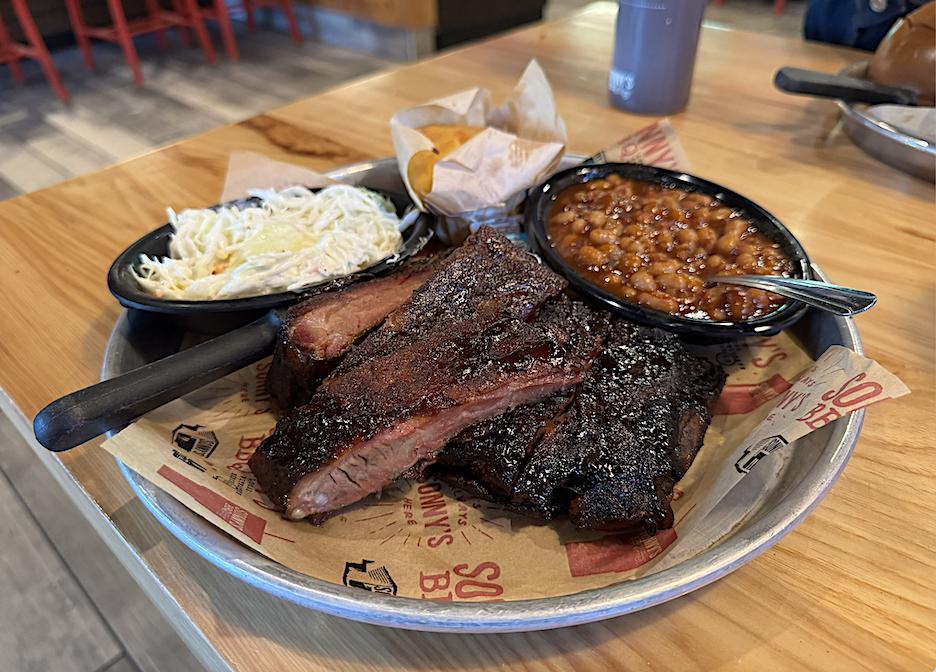
When it comes to barbecue ribs, I have one inviolable rule: They must be fall-off-the-bone. I have no interest in gnawing on ’em. I want the bones to end up shiny as freshly brushed teeth. This week, I’m homing in on chain barbecue restaurants. There are really only two in these parts: Dickey’s Barbecue Pit (est. 1941, Dallas, Texas), with four locations in the greater Tampa Bay area, and Sonny’s BBQ (est. 1968, Gainesville, Florida), with six. Both menus indicate that I could expect their ribs to fall off the bone. DICKEY’S BARBECUE PIT Monday’s weather had been all-day dreary, although it had stopped raining when we arrived at 6:30. The Tyrone-area restaurant’s’ gray exterior matched the drab sky, but once inside I got energized by the thought of eating BBQ ribs for the first time in many, many months. Right off the bat, I hit the counter woman with, “Are your ribs fall-off-the-bone?” “Always,” she shot back, before I could finish the question. Okay, then. Let’s get’r goin’. We ordered a half-rack Rib Plate ($18.99) with two sides: hand-cut fries and barbecue beans. For sauces, we got one container of the Dickey’s house flavor and one sweet. Appearance Your basic presentation of a rib meal at a counter-serve barbecue joint. I was rarin’ to dig in. Taste and Texture The counter woman was true to her word. These ribs fell off the bone — but not so much that they came apart at the slightest touch. These were ribs you could pick up and eat. And they were damn good — the meat sublimely tender, with just the right measure of smokiness. I wasn’t interested in sharing too much of my grub with Bonnie, although I kept that to myself. One rib in, she announced, “I’m done,” and my face lit up. The fries were nice: long and bordering on limp. It was like eating, y’know, potato. The beans held their own, but they had a bit too much of a congealed texture. Of the two sauces, we preferred the house version, tangy with a hint of spicy heat, although we only sampled it. I generally don’t dip my ribs in sauce. I wiped out the rib plate, which I knew would happen even when Bonnie tossed in her napkin early. SONNY’S BBQ We arrived at the Pinellas Park location at 4:45 Thursday, a blazing hot, rainless, puffy-clouded afternoon. The aroma of smoke swaddled us just inside the front door. The large dining room is outfitted like a Western roadhouse, with different tones of wood offset by bright red chairs. We had our choice of tables so set up at a six-top by the window on the back wall. Our server, Stephanie, arrived promptly. All of Sonny’s ribs are fall-off-the-bone, she said, but the St. Louis style has more fat, and therefore is more juicy, and she strongly recommended them. How could we not? I ordered St. Louis Ribs ($18.29) with BBQ beans and coleslaw as sides. Bonnie got tater tots with her pulled pork sandwich. Appearance Compared to the competition, this presentation of a barbecue rib meal was durn near elegant. Then again, Sonny’s is a full-service restaurant, so that’s to be expected. Like a few days prior, I was rarin’ to dig in. Taste and Texture Fall-off-the-bone redux. These ribs had a prominent char that added to the smoke quotient and required some extra jaw work. They were tender and smokey and flavorful, as expected, but not as moist as those at Dickey’s. My half-rack included an end cut, which had very little meat and was mostly burnt black. I gave it a go anyway. (Stephanie told me later to order “center-cut ribs.” Useful information, indeed.) The sweet beans were so syrupy that they came with a spoon. The coleslaw had more sauce than I prefer, but I finished it all the same. Bonnie’s tots, a few of which I stole, were perfectly done. A welcome bonus was a splendid cornbread muffin — moist and sweet. And the Winners of the Chain vs. Chain Rib Ruckus Is … A split decision … Dickey’s Barbecue Pit. I preferred the vibe at Sonny’s. I preferred the beans. I preferred the potatoes. I far preferred the cornbread over the so-called Texas Toast at Dickey’s. But ultimately I preferred the ribs at Dickey’s, so I’m duty bound to declare it the winner by the thinnest of margins. As to where I’d choose to go for another rib plate, it’s Sonny’s. A final note: Even though my two rib dinners in a week covered my fat-intake quota for a month, I have no regrets. Well, maybe one: I wore tan shorts to Sonny’s.
Cod Piece: Tampa Bay vs. Catalonia, Spain in a Fish Fight
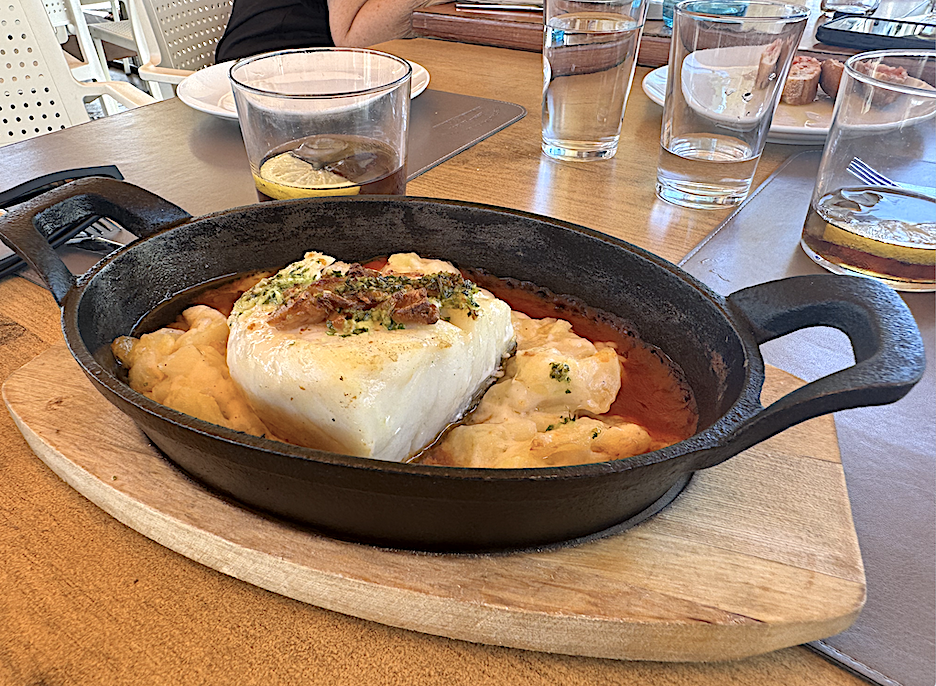
I’ve always wanted to take Friday Food Fight international, make it global, huge. Not really. I’d just hoped to do one pitting Tampa Bay against a foreign country. Dream fulfilled when we recently took a 10-day trip to Spain, where we stayed a couple nights in Barcelona and then the rest in the hilly part of a small town called Vall-Llobrega*, about 70 miles northeast. The plan was to survey the culinary scene in Catalonia, and then see if I could match a dish with one here. Initially, paella seemed the obvious choice. But I did not like paella, at least the stuff in Barcelona. It was during a side trip to a medieval town called Pals that I found my food. Cod. At a restaurant called La Vila. Now, cod (bacallà in Catalan) is common there, but not here. So finding a Tampa Bay competitor took a little effort. Up popped one close by: Bonefish Grill on 4th Street in St. Pete … I know what you’re thinking. Cod at a medieval town in Spain vs. cod at Bonefish? Hey, I get it. On paper, it’s a grievous mismatch. Let’s find out. LA VILA After strolling along hilly cobblestone streets in mid-90s heat, under full sun, and needing shelter and food, we found La Vila. Our party of six did not have a reservation, but after a 15-minute wait and some mild truculence from the staff — shame on us for being walk-ins — they found us a table on a covered patio just before 2 p.m. The extensive menu was in Catalan and Spanish. Our waiter, a middle-aged fellow, spoke little English, so we had some trouble ordering (and he could barely conceal his exasperation). He didn’t know the word “cod,” so I looked it up on my phone. Bacallà. I was surprised there was only one Bacallà dish (€19) on the menu. Translated: baked cod with crumbed garlic and cherry oil, over potato gratinate. Appearance An impressive presentation for a lunch that cost about $22. A healthy portion, too. And I’m predisposed to dishes in cast-iron serving bowls. Taste and Texture As a decades-long resident of Florida — the land of grouper and snapper and grocery-store tilapia — I haven’t eaten much cod. This version was a splendid change of pace. It had plenty of flavor, but not in a “fishy” sort of way. The Catalan cod was meatier and oilier — and less flaky — than the Florida Gulf fish I’ve had. The bed of potatoes was scrumptious, just the right mid-point between creamy and firm. I’ve never knowingly eaten cherry oil (I tasted no cherry), but the velvety red sauce provided a first-rate obbligato. The portion size was spot-on. I polished it off. Who needs leftovers on a European vacation? BONEFISH GRILL First, kudos to Bonefish for serving cod. We showed up just after 6 p.m. Thursday at the flagship location (which opened in 2000) and had a 10-minute wait. The interior is dark(ish). The design, let’s call it old-school. We sat at a high-top in the bar area, which was close to capacity and thrummed with robust conversation. Our young server, Gwen, was delightful — energetic, witty and knowledgable. I’d like to have a fraction of her pep. She gladly helped me improvise a cod dish: Cod Imperial ($25.90), the filet lightly grilled then baked. I ordered the Imperial — a mix of shrimp, scallops and other rich stuff — on the side. Garlic whipped potatoes and asparagus completed the meal. Appearance I could’ve done without the Imperial — its ingredients are outside my wheelhouse — but Bonnie wanted to try it. The cod was dusted with some type of spice, I’m not sure what. Stalks of asparagus draped across the potato, adding a smidge of flair. Taste and Texture A worthy chunk of cod — similar in flavor and texture to its counterpart across the pond. The spiced exterior provided some zest, but I wonder if adding a bit more to create a crust would be an improvement. In all, I found the density of the cod to be a welcome alternative to the flakier fish common in local restaurants. I liberally buttered my potatoes, and scarfed ’em up. The asparagus could’ve been firmer to add some crunch, although it wasn’t limp. And the Winner of Tampa Bay vs. Catalonia Cod Clash Is … La Vila. The match was closer than expected. The cod itself was actually comparable between the two places, but La Vila’s unique red sauce and potato gratinate won the day. As far as service, Bonefish Grill wins — Hands. Down. Gwen was the kind of server who makes the dining experience better. *About pronouncing Vall-Llobrega: I could find no clear consensus. I didn’t think to ask a server at a restaurant in town so resorted to online research. I couldn’t find audio, just ph0netics. I’m going with the Spanish version: Bye-Yo-Breh-Gah. And finally: Another big congrats to Emmitt and Albane on their nuptials. (I presume you’re still married.) We had a blast.
Friday Booze Fight: A Three-Martini Mashup at Mandarin Hide
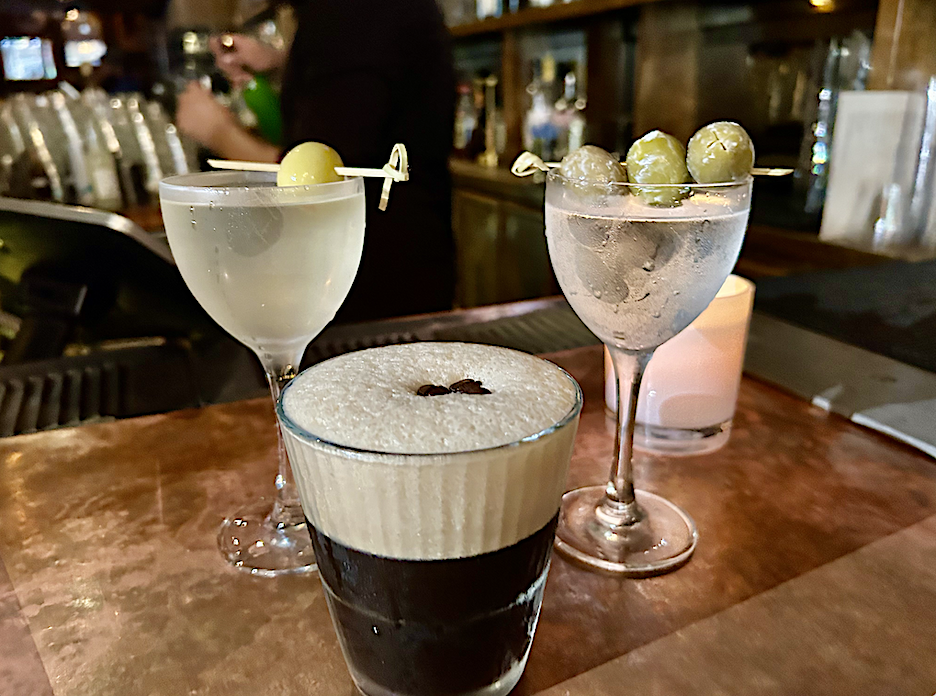
Remember the three-martini lunch? Neither do I. At least not in practice. The mere idea of slurping a trio of potent liquor drinks in the early afternoon seems the height of Don Draper-esque madness. For our three-martini Spotlight at Mandarin Hide in downtown St. Pete, we gathered at a more sensible time — 6:30 p.m. Sydney, the youngest member of the Registry Tampa Bay team, strongly suggested Mandarin Hide, mostly because the place makes “the best espresso martini.” Okay, sold. And she showed up! Two other martini testers were in attendance: Tom duPont, publisher of RTB, and David Downing, a regular FFF consultant and expert libation photographer (all photos are his). Both have considerable expertise regarding the iconic drink. Me, not so much. I’ve had maybe a half-dozen martinis in my life. The four of us grabbed stools at the corner of the bar nearest the door. We ordered three martinis — all with vodka instead of gin, which David met with mild disdain. They were: 1) dry, 2) dirty and 3) the aforementioned espresso. I portioned out small samples in plastic cups to the team members, and drank from the glasses myself, including the all-important first sip. I’ll pick a winner — or more accurately my favorite — and reveal it at the end. DRY MARTINI We got into a spirited discussion about this drink before it was served. Tom said the dry martini is made with (in this case) vodka and three olives stuffed with bleu cheese. “If it’s just vodka, why don’t they just call it vodka?” I pleaded. “Why call it a martini?” Our good-natured bartender, Ben, two weeks on the job, made an attempt to intervene, saying he could make it any way we wanted it. Another bartender came over and said that the Mandarin Hide dry martini is prepared by rinsing the rim of the glass with dry vermouth. Settled. Tom asked Ben to use Ketel One vodka. As I lifted the glass to my lips, I was prepared for the bite of clear liquor but was surprised to find it smooth and refreshing — in a 80-proof way. The martini was cold, for starters. I didn’t actually taste any vermouth, but somehow it made its presence felt. My first thought was, “I don’t want to share. I don’t want these people to have any of this martini.” But I dutifully doled out a thimble’s worth to each, spilling some on my pants, and leaving me with a couple thimble’s worth. The three men each took an olive. I took a bite of mine — appreciating the tang it emitted with the sharp cheese — and dropped the rest on the floor. I swear I was only mildly buzzed. I’d only had one Bud Light as a palette-cleanser. I was unaware of the custom that mandates bartenders must use one or three olives when making a martini. An even number is bad luck. I did some searching and could find no definitive reason for this superstition, but the number of olives didn’t matter much to me. All I know is that I enjoyed my dry martini far more than expected. DIRTY MARTINI One olive accompanied our dirty entry. I don’t remember who got to eat it. I do remember that it wasn’t stuffed with bleu cheese. I knew going in that a dirty martini included olive juice (or brine). I like green olives, but I didn’t expect the olive flavor to be so powerful. If part of the raison d’être is to mask the taste of the liquor, it does a good job. The olive imbued in the martini an intense saltiness. “It’s amazing how two drinks can be part of the same family and look so much alike, but taste so different,” David said. That about sums it up. ESPRESSO MARTINI Sydney informed me that the espresso martini is a favorite among the young bar crowd, especially late at night, because of its blend of booze and caffeine. This tidbit clearly had no bearing on my life, but I was pleased to find out that at least some of the kids had moved on from vodka and Red Bull, a most vile concoction. We were clearly in different martini territory here — different color, different ingredients, different glass. And froth, lots of froth. Way different flavor, obviously. Mandarin Hide uses 360 vodka and Borghetti Caffe Espresso in its version, and tops the foam with coffee beans from Kahwa (a local brand) — three of them, representing, per Tom, “health, wealth and happiness.” I was down with that. I carefully sipped, hoping to spare myself the indignity of a froth-covered mustache. The drink combined sweetness with a bold coffee flavor. The vodka was just about undetectable, which — I’m guessing — is part of the point when young folks are trying to push on into the wee hours. And the Winner of the Three-Martini Mashup at Mandarin Hide Is … The dry martini. This was an easy choice, and I see another dry martini in my future. The others, probably not. Just to be clear, my “winner” makes no comment on how well Mandarin Hide made the other two. My assumption is they’re first-rate. The dry version was the preference of a martini dilettante. Someday I’ll say to a bartender, in my best suave voice, “Vodka martini, dry, three olives.” I do not like gin. Sue me. A final note: I had a terrific time, and I think the others did too.
Taking Tart to Heart: A Clash Over Key Lime Pie
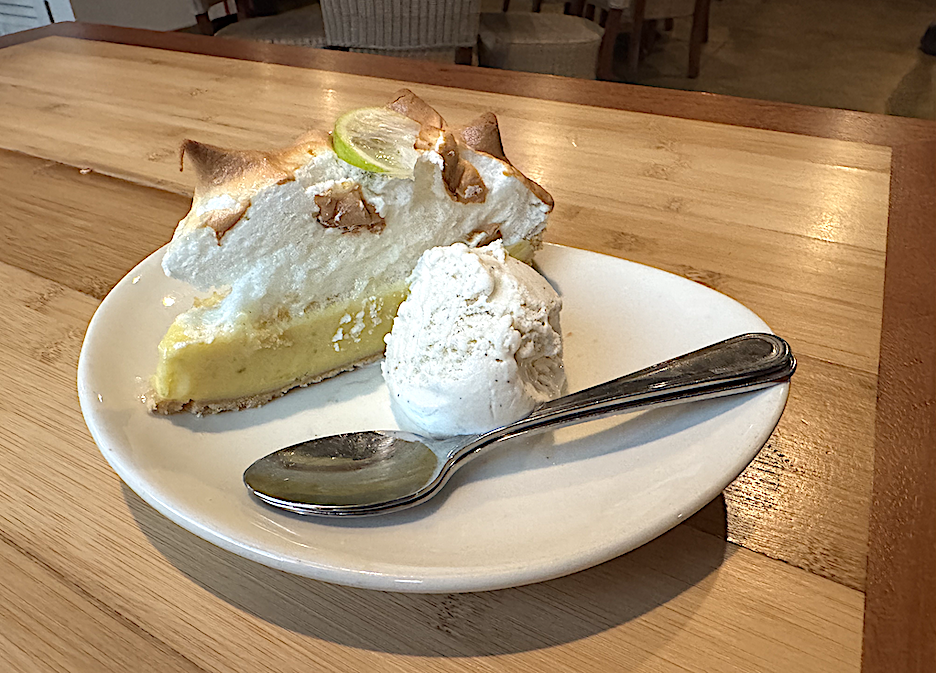
My first time eating key lime pie left a sour taste in my mouth. I was in my 20s, not long from upstate New York — where all you could really develop were pedestrian culinary tastes — and I didn’t understand a dessert that was not all-the-way sweet. I scratched it from my personal menu. Bonnie did not care for it, so we dug our heels into an I-don’t-like-key-lime-pie stance. High time for a reappraisal. And I think I’m ready. Rather than buy whole pies from a bakery, we chose the restaurant route, both of them coastal-themed: Rumba Island Bar & Grill on 4th Street in St. Pete and The Toasted Monkey on St. Pete Beach. RUMBA ISLAND BAR & GRILL We arrived just before 7:30 Tuesday to a nice surprise. Rumba Island offers a new special: dinner-for-two for $25. As a bonus, you can add a slice of key lime pie, with vanilla ice cream, for $4.99, a dollar off the usual price. We each got an entree from the generous twofer menu, and added the Rumba Salad ($9.99). Rumba Island’s interior is functional — roomy, with plenty of space between tables, a lot of beige. The interior features nothing pirate-themed (that I could see), and for that the restaurant has my gratitude. We sat at a four-top next to a window. Only two other tables were occupied, so ambient noise was all but nil. Appearance I didn’t recall having key lime pie with a side of ice cream, but I was game. The meringue, lightly browned on top, was a plus. (Curious, I checked images online, scrolled down quite a bit, and didn’t see a key lime pie with meringue — or a side of ice cream.) Kudos to Rumba Island for being different, if not exactly innovative. Taste and Texture First bite: not too tart. Off to a good start. I could feel my I-don’t-like-key-lime-pie stance starting to wobble. The yellow stuff was cold, bordering on crystalized, as if it hadn’t fully thawed. That made the texture more solid than creamy. I had to press down with my fork to free up bites. They gave my mouth pops of cold. Add in ice cream and I nearly got a cold headache at one point. This is not a complaint, exactly. I would’ve prefered the pie warmer, but I was still enjoying it. It’d been a long time since I’d had meringue. Fun. THE TOASTED MONKEY We arrived at 7:50, about 25 minutes before sunset. The outdoor patio was humming, with a one-man band playing a drum kit, singing and running programs to perform classic rock (he had the flowing locks to match). We chose to sit inside — a large, plainly decorated space with a concrete floor — at a four-top next to a window. I saw that the light was fading fast so asked our server, Miley, if she could bring out an order of Key Lime Pie ($7.50), stat, before the room got too dark. She gladly obliged and hustled it to our table in a couple of minutes. After photos, she returned the pie to a refrigerator while we ate our entrees. Appearance I prefer my pies to come in slices, but the three squares were a niggling matter. It all comes down to flavor. Taste and Texture The Toasted Monkey’s menu say it makes key lime pie in-house, impressive for a beach bar that only serves drinks in plastic cups. The yellow stuff was firm and walked a fine line between bold and mellow. It had a graham-cracker crust, a plus. Some crumbles of cinnamon atop the whipped-cream icing came as a welcome surprise. And the Winner of the Clash Over Key Lime Pie Is … I made a smart play and brought home pieces of each pie for direct comparison. I referigerated them overnight, then pulled them out and let them warm for a few minutes. I alernated bites. It was a rewarding way to spend some time on Thursday afternoon. And the Winner Is … The Toasted Monkey. In a close, spit decision. The Toasted Monkey pie was firmer than its competitor, and a bit more tart, with more lime flavor. I preferred the graham cracker crust and appreciated the hint of cinnamon. Overall, it was a more stout helping of pie — one that, after decades, I was ready for. The Rumba Island version was creamier and went down smooth. I liked the airy tastes of meringue. The ice cream provided a major bonus. I’m pretty sure the portion was bigger, and I preferred the wedge over the three squares. (Bonnie liked this version better, although her vote doesn’t count.) As an overall dessert, I’d probably lean — ever so slightly — to Rumba Island’s. Hence, the split decision. But this was a contest over key lime pie, so The Toasted Monkey gets the final nod. A Parting Note: I can say now, without equivocation, that my I-don’t-like-key-lime-pie no longer applies. I will order it again, and I may even pick up a whole pie at the grocery store.
Jamaican Brown Stew Chicken: A First-Round Knockout
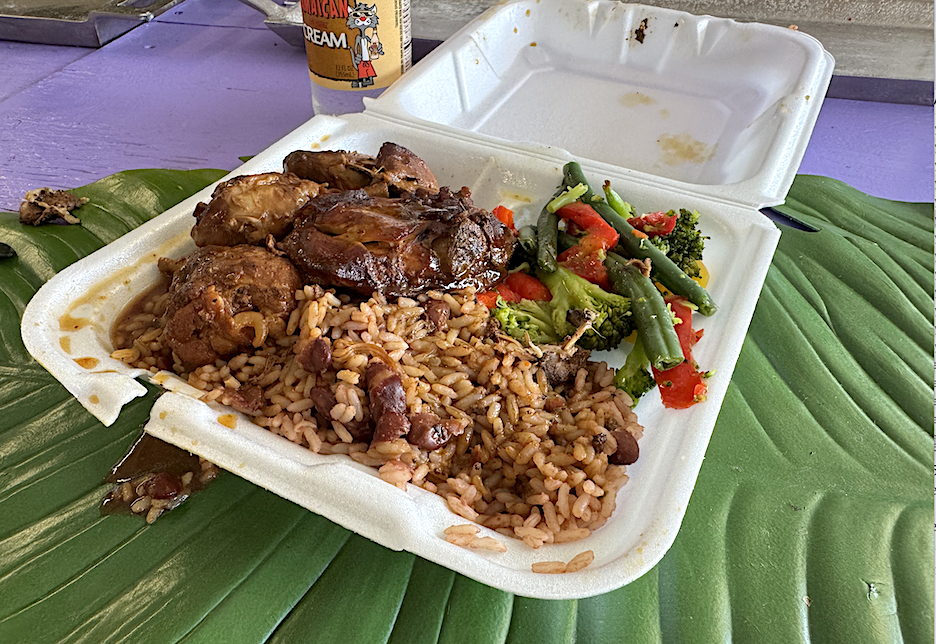
An 11th-hour detour this week, unprecedented in the annals of Friday Food Fight. I had orginally planned to do the usual 1-on-1 match between two restaurants — in this case a joust over Jamaican brown stew chicken. As it turned out, one restaurant was so superior to the other that I’m going to feature it and it alone. To square the two off would’ve resulted in a first-round KO. I don’t think its fair to name the other place, which was — let’s just say … not good. Besides, why waste words on it when I can spend more describing my delightful meal and experience at Island Flavors and Tings? All told, Thursday (yesterday) afternoon turned out to be a fun culinary adventure. I had originally planned to use Miller’s Jamaican Spice Cuisine in south St. Pete as a contestant. Brown stew chicken is on its Thursday menu. I called just to make sure, and was told the dish was not available. No biggie. I pivoted to another Jamaican place. After walking in, I started chatting with a woman customer and told her what I was up to. “Go to the place on 49th Street,” she murmured. After a little back-and-forth with her, I looked it up on my phone and — less than two miles away — there it was: ISLAND FLAVORS AND TINGS The restaurant is located in a rundown strip center on a worn-out section of 49th Street South that’s the eastern border of Gulfport. Island Flavors does not have a sign that’s visible from the street. It does not need one. When I arrived at 1:15, about 10 folks were queued up, waiting to be served cafeteria-style. (When I left 50 minutes later, the line was a longer.) I liked the vibe straight away. Several women worked the cafeteria line and checkout, slipping in and out of the kitchen. They looked to be in a good mood and weren’t in in a hurry, so I decided to be in a good mood and not in a hurry. Had I wandered into Island time? Shelves held West Indian products, joined by an eclectic array of bric-a-brac. The checkout spot had a thatched tiki roof. Reggae played at modest volume on a decent sound system. I ordered a small Brown Stew Chicken ($10.95) with rice & peas (actually beans) and mixed vegetables. The server asked me if I wanted extra sauce. “All you can spare,” I replied, and she obliged with a couple of large spoonfuls. On impulse, I added a quarter Jerk Chicken ($4.50), then noticed Helena’s Mango Bread. I added a thick slice ($3.75) in a plastic container. I sat at a bar across the room and placed my takeout box on a plastic placemant shaped like a banana leaf. The bottom part of the container broke when I opened it, spilling out some of its contents. Within a few moments, two women sat next to me, and one asked me my name. We introduced ourselves and had a pleasant conversation. It was warm at the bar, and a fan blew hard on me. I didn’t mind. Taste and Texure So good. Way better than good. All of the chicken consisted of thigh pieces, my favorite part. No leg, no wing, no white meat. Fall off the bone, delicious. At a certain point, I ditched the plastic knife and fork and ate the bird with my hands. And if my fingers got messy with sauce, so much the better for lickin’. This stuff was nectar of the gods — velvety, with a hint of sweetness. Rich, but not cloyingly so. And the ideal consistency, midway between gravy and juice. The rice & peas, well-sauced, provided excellent accompaniment, and the veggies — broccoli, peppers, green beans etc. — were firm and mildly salted to enhance their flavor. I took a few bites of the jerk chicken — another winner, with a smidge of spicy heat — and saved the rest for later. Even after I made a significant dent in the meal, a lot remained. And remember, this was the “small” portion. I packed up the leftovers and cleaned my placemat. As I turned to leave, there sat a large fella next to me. He said hi. His name was Don. He had an easy smile and a remarkable basso profondo voice that oozed warmth. We chatted amiably for about five minutes. Rising to leave, I quipped, “I’m sure you’ve got to get back to your radio show.” He laughed. It was one of those moments. In fact, my entire visit to Island Flavors & Tings felt as if it were ringed by a halo. I played Peter Tosh on the ride home.
Croque Madame Madness (and an Existential Food Question)
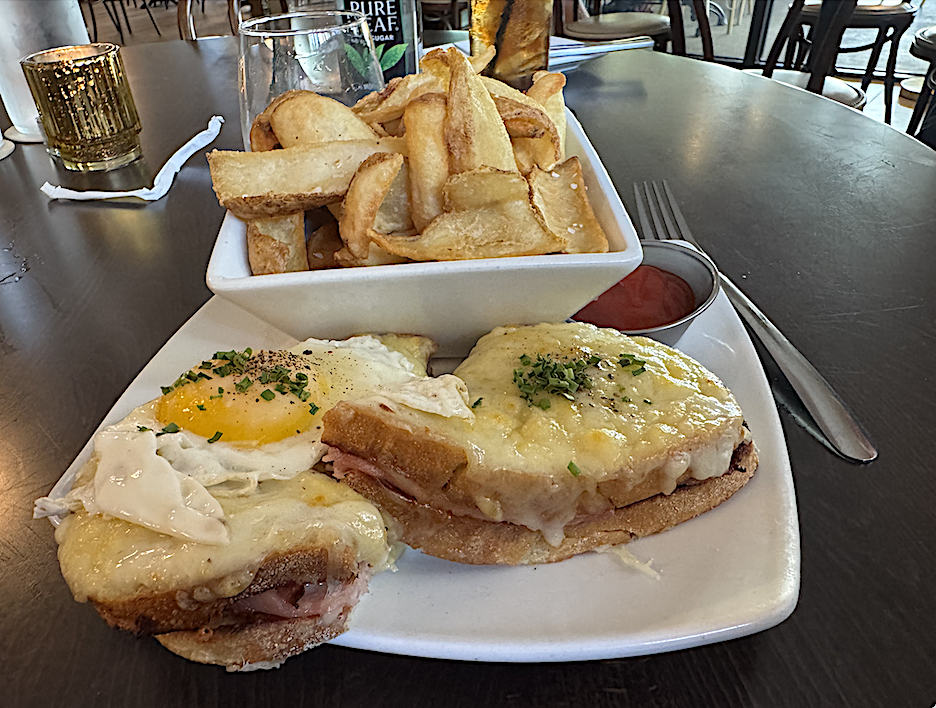
When Bonnie suggested Croque Madame for this week’s dish, I nearly demurred. Just the name sounded too chi-chi for a ham ’n’ egger like me. On closer inspection, though, I discovered that the Croque Madame actually includes ham and egg (one, fried or poached). And cheese. And bread. It’s — what? — a sandwich. Man, I’m all about sandwiches. Croque Madame translates, roughly, to Mrs. Crunch, a nod to the crisply toasted bread. No surprise, it originated in France in the mid-1900s as an offshoot of the Croque Monsieur, the same sandwich without the egg. (I can’t resist pointing out the reproduction metaphor here. Discuss.) As contestants, I chose two French (or at least French-ish) restaurants: Cognac, a new place in downtown St. Pete that bills itself as a French brasserie, and La Croisette, a cafe on St. Pete Beach that dates back to the 1980s. COGNAC The restaurant, which opened in February, sits at the corner of 2nd Street and 2nd Avenue North, a spot most recently occupied by Dirty Shirley, which closed down within 10 months, probably because of its name alone. Cognac exudes a casual elegance. At 6:30 Tuesday, the dining room was bathed in natural light courtesy of large windows all around. French pop played at low volume, adding to the cozy ambience. Small chandeliers, each one different, hang from the ceiling, a charming design element. Simple wooden tables and chairs are well-spaced. Bonnie and I sat at a four-top near a window. Our young server, Matt, was friendly and attentive. We ordered our Croque Madame ($17), with house-made fries. Appearance My first impression: decadence. Two large halves of sourdough bread were blanketed by melted Swiss cheese. Sexy, too. The egg, sunny-side up, eyed me seductively. The ham was all but invisible. Texture and Taste This Croque Madame raised an existential question: Is a sandwich a sandwich if you need a knife and fork to to eat it? Discuss. I made sure my first slice went through the egg, so the yoke ran onto the plate. Better for dipping. I knife-and-forked my way through most of her. It was slow going, but in a good way. The bread had a bit of burnt crust on the edges; the rest was soft and chewy. In all, the Croque Madame was the very definition of savory. The ham, several slices worth, provided saltiness but took a backseat to the cheese, which lent a hint of sharpness. The ingredients blended well, making for an indulgent meal. The thick fries were soft on the inside, with an authentic potato flavor. LA CROISETTE The pink building is situated on Beach Boulevard at the western edge of the Corey Avenue Shopping District. We arrived at 1:30 Wednesday, 30 minutes before closing, amid a light rainfall that glistened the pavement. La Croisette has an elevated diner vibe. Three black-clad female servers hustled around the small(ish) dining room, which was nearly full. Dana, the GM, similarly dressed, pitched in. The women gave the place some zing. The unfussy interior design consists of simple tables and booths under a white drop ceiling. We made ourselves comfortable in a booth next to a window. I ordered my Croque Madame ($14) on sourdough with the egg sunny-side up and home fries as the side (with onions, for an 80-cent upcharge). Appearance Expectedly, this Croque Madame had a more diner-style presentation than the one at Cognac. The most notable difference was the lack of cheese slathered atop the sandwich. The home fries had a decidedly reddish hue. Taste and Texture In general, this Croque Madame was more polite than the competition’s but was not a sandwich to pick up and eat. So, back to the knife and fork. The cheese coated the bottom piece of bread, muting its presence and pushing the ham forward. The egg was cooked a tad past “easy” and therefore the yoke did not run onto the plate. The bread was nicely toasted. The home fries were exemplary. Paprika and some other secret spices (according to Dana) gave the potatoes their red tint and a tinge of unique flavor that set them apart from your basic ham ‘n’ egger versions. The pieces came in various shapes and were ideally sized. Adding the onions was the best 80 cents I’ve spent in a while. Perfectly cooked, they added a welcome level of crunch. These were the kind of fried taters than I could eat as a meal. And the Winner of Croque Madame Madness Is … Cognac. It boiled down to a matter of preference: a thick coating of cheese on top — or not. I preferred yes, Bonnie went with not. (But her “vote” is purely ceremonial.) The runny egg yolk at Cognac played a key role in my decision. La Croisette won the battle of the sides. I must remember to eat more home fries at lunch — and dinner.
High Steaks: Filet Mignon vs. New York Strip at Bascom’s Chop House

I drove around Bascom’s’ two parking lots and finally found a spot on the outer fringe. It was 6:30 — on Tuesday. Yeah, business is good. I was there to meet Tom duPont, the publisher of Registry Tampa Bay, for a steak feast at this legacy restaurant that opened in Feather Sound in 2001 but seems like it’s been around longer. We’re taking a new tack for this week’s Friday Food Fight. Instead of picking two restaurants to battle it out over the same dish, we visited one restaurant and pitted two dishes against each other. It’s called a Spotlight feature, and we’ll run them occasionally in this space. Bascom’s was — no surprise — packed. The host showed us to a four-top at the end of a narrow room. The interior has a traditional steakhouse feel, and the lighting leans dark. Now for the contestants: In Tom’s corner was the 6 oz. Filet Mignon ($39), cooked Pittsburgh. medium rare. My entry into the ring was the 14 oz. New York Strip ($48), cooked Pittsburgh medium. We added a few sides, plus a salad and dessert for each of us. I got a 3 Daughters Beach Blonde Ale in a 16 oz. can ($7), then another. Tom had one glass of red wine. We were all set to eat like kings. I’ll pick a winner at the end. (Tom doesn’t get a vote.) Let’s do this semi-chronologically … Bascom’s House Salad The mixture of iceberg lettuce and spring mix, with julienned ham and Swiss cheese, along with heirloom tomatoes and olives, made for an ideal opener. It came dressed in a tangy Parmesan vinaigrette dressing, sprinkled with grated Parmesan on top. Tom had a Classic Caesar, no anchovies. I didn’t try it. Both salads were $10. Filet Mignon Tom suggested we get both steaks cooked Pittsburgh, which gave them a more pronounced outer char. This filet ate bigger than it looked, although Tom wasn’t particularly generous in the few slices he gave me. (I can’t say that I blame him.) The crispy edge gave way to a slightly chewy phase, which then became butter — or should I say buttah. In all, a winning combination of delicate flavor and contrasting texture. Tom got the Truffle Parmesan Fries ($14) — a big bowl’s worth, shaped like flat ovals. I stole a couple. Excellent. New York Strip I don’t often eat at steakhouses, and when Bonnie serves steak at home — infrequently — it’s nearly always filet. I couldn’t recall that last time I sat down to a New York Strip. The Pittsburgh method benefited this steak as well. I’m thoroughly down with that almost-burnt exterior. The beef was a shade past medium on each end — not a whole lot of pink, but still tender. That shallow pool of rich juice on the plate came in handy. When I reached the middle section — bliss. The meat had a melt-in-mouth feel similar to the filet, but with an earthier flavor. Juicier, too. For sides, I got a loaded Baked Potato ($7), bacon bits and all, and Cream of Spinach ($9). Each lived up to its steakhouse-style promise. I made good headway, but couldn’t finish either one. Cannoli Waffle Crisp I tend to pore over dessert menus, changing my mind several times. Such was the case at Bascom’s, which has several items — all house-made — that tempted me. I finally decided on the Cannoli Waffle Crisp ($13), and was glad I did (no disrespect to the Blueberry Cheesecake, which was in serious contention). The dessert was artfully presented, with strawberries, blueberries, blackberries and chocolate chips scattered around thick waffle slices and sweet, decadent ricotta dip. I tried a bite with the cognac fudge sauce but found that the dessert worked better sauce-less. This elevated Italian-esque confection was the perfect capper to the meal. And the Winner of the Filet Mignon vs. New York Strip at Bascom’s Is … The New York Strip. By the thinnest of margins. My gut says I preferred the New York Strip Tuesday night because it was a departure from the type of steak I usually eat, filet mignon. This was such an enjoyable meal. Tom and I ate and talked, ate and talked. It was one of those feasts that, after you’re finished, you survey the vestigial remnants on the table and wonder how you ate that much. And somehow I wasn’t stuffed. I drove away understanding at least one reason why the Bascom’s parking lot was full and it was packed inside. The food is terrific. One last thing: Thanks to ever-smiling Emily for the efficient and unobtrusive service.
Hot Pastrami on Pumpernickel: A Tale of Two Delis
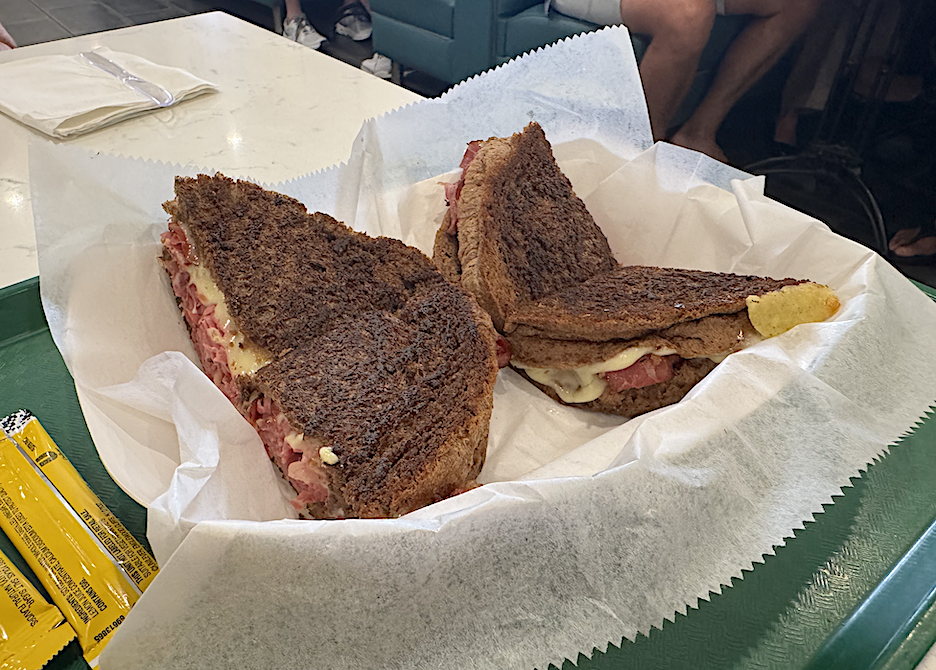
A friend and former teammate from high school in New York suggested featuring pastrami. It’s a sandwich I like but rarely get and never make. I’m more inclined to pastrami’s cousin, corned beef. But pastrami was a tasty idea, and it stuck. We went out Wednesday afternoon and hit two delis in South Tampa for pressed pastrami sandwiches on pumpernickel: Wright’s Gourmet House (est. 1963), which stretches the notion of a deli, and Schiller’s German Delicatessen (est.1952). When I got home, it struck me: What, exactly, had I just eaten? Pastrami is a cured meat made with (usually) beef brisket, which is brined, seasoned, smoked and steamed. Despite its Italian-sounding name, pastrami originated in Romania — before refrigeration. WRIGHT’S GOURMET HOUSE I’ve lived in St. Pete for a very long time and worked in Tampa for extended stretches but had somehow never made the pilgrimage to Wright’s until Wednesday. The place is enormous. Two large dining rooms sit next to a massive deli area that has belted stanchions to manage lines — like TSA. I’d never seen that. At 12:30, we somehow missed those lines. When I ordered my $14 Hot Pastrami on pumpernickel (with “mustard sauce”), the counter person asked, “Would you like to add cheese?” I took that to mean it would be an extra charge, which turned out to be a dollar. (Hey, every dollar counts.) I got Swiss, passed on a side order. I gave her my phone number so staff could text me when my order was done. We sat at a two-top in a dining room that was nearly full and in about 10 minutes I got the ping and picked up the sandwich. Appearance Not pretty. Four dark-brown triangles sitting on paper. No acouterments. A dill pickle, maybe? Rye might have made for better picture. Taste and Texture The bread had a well-calibrated crisp on the outside, and a robust flavor. (It’d been a long while since I’d had pumpernickel.) The pastrami, sliced thin, was mildly chewy, but easy on the jaws. The Swiss, perfectly melted, oozed from the sides of the sandwich but not onto my fingers. All told, it made for a tasty return to hot pastrami. I ate half. Another one awaited. SCHILLER’S GERMAN DELICATESSEN Everything Wright’s is, Schiller’s isn’t, and vice versa. Located at the corner of El Prado and Manhattan, it appears to occupy a former convenience store. The Schillers no longer own it, and this is not the original location. Inside, the place is lined with shelves full of products, most of them German. Two young fellas — Eben, one of the owners, and Zack — were manning the shop. I talked NBA with Zack. When I find someone who can chat intelligently about the league — especially during the off-season — it’s an instant bromance (no slight to you hardcore women NBA fans; I don’t know any). I ordered the New Yorker ($9.95), which included Swiss, coleslaw, mustard and Thousand Island dressing. Zack and I discussed Paolo Banchero’s new contract and other NBA buzz while he made the sandwich. (He actually sliced the meat, like a real deli.) We sat at a four-top amid the shelves. I ate. Bonnie, not a fan of brined meats, did not. Appearance More of the same, only plainer. It became apparent that no matter how many flag-topped toothpicks or sprigs or other bibelots accompany a hot pastrami on pumpernickel, it’s still an ugly brown thing. I asked for and was happily granted a small container of sliced dill pickle. Taste and Texture Fresh off the press, the sandwich was hot when Zack handed it to me. The bread was impeccably toasted. The pastrami, laid on thick — but not so much that I had to unhinge my jaws — was just as tasty and a shade easier to chew than the competition’s. Purists might get the vapors over the thought of adding coleslaw to a hot pastrami, but I really appreciated the crunch and touch of sweetness the house-made stuff added. Somehow the Swiss cheese struggled to make itself known. Wanting to avoid a gut bomb, I ate half. Zack packaged it up nicely for later. And the Winner of the Hot Pastrami on Pumpernickel Competition Is … Schiller’s German Delicatessen. The sandwiches were about equal, although I give Schiller’s the edge due to the inclusion of coleslaw, however unorthodox. I generally avoid discussing price in FFF, but the Wright’s sandwich costing a third more than Schiller’s’ was hard to ignore. I admired the systematic efficiency of Wright’s, the mondo-deli’s ability to turn out a quality product quickly to such a large clientele. At Schiller’s I felt at home, even if it lacks the comforts. One last thing: Thanks for the idea, Doug.
Seeking Kernels of Truth: A Fracas Over Fried Rice
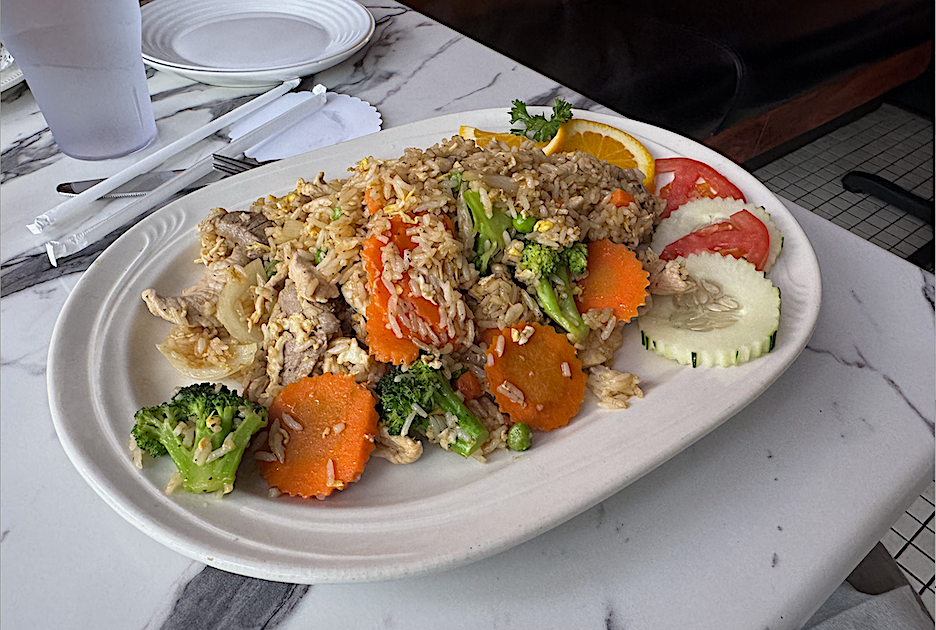
Fried rice — the gateway dish to Asian food — tastes good, it’s hard to mess up, it’s cheap, it’s fairly consistent from restaurant to restaurant. It’s also, um, unexciting. Can fried rice even be exciting? While it’s now a staple of most Asian restaurants, I first knew it as Chinese food. Fried rice did originate in China during the Sui Dynasty (589-618 AD), which is pretty specific as far as food history goes. We did not set out this week to find fried rice that wowed us. Why should it suddenly happen now? Instead, I wanted to pay close attention and see if I could detect subtle differences between two restaurants, neither of which turned out to be specifically Chinese: Moonlight Boba in Pinellas Park; and Pin on Grand in St. Pete’s Grand Central district. MOONLIGHT BOBA The little eatery with the romantic name is tucked away in a modernish building on US 19 just north of 62nd Avenue. We were the only customers at 6:45 on Monday. Moonlight Boba’s interior is sparsely furnished with little in the way of overtly Asian design elements. The well-lit place has a service counter in the middle, with high-tops on one side and low-tops on the other. Our smiling, quick-witted counter person, Ella, a college student, called herself a “bobarista.” We spent most of our meal chatting with her. I wanted to try three protein options — chicken, beef and pork — in my Hibachi Fried Rice. Because there was no combo price, this led to some tricky (and improvised) math — for a total of $19.98. Bonnie got Vegetable Fried Rice ($9). I also got a Mango-Strawberry Milktea with Honey Boba ($9.23). I’ll write a few words about my first boba drink at the end of the column. Appearance It never came up that we planned to dine in, so Ella brought out a stack of styrofoam to-go boxes in a bag. Bonnie grabbed a big spoon and crafted a photogenic bowl of fried rice. The above photo does not include large helpings of beef, pork and (especially) chicken that we portioned from the takeout box. The meal came with a container of creamy yum-yum sauce. Taste and Texture The rice clung together appropriately, not in clumps. The veggies — green beans, peas and carrots — were cut small. I wondered whether they’d been chopped up in-house or came from a frozen bag. (I didn’t ask.) Of the meats, I liked the pork, while Bonnie preferred the beef, which reminded her of the type in Philly cheesesteaks. The chicken was chalky, and we ate little of it. The sauce was, in fact, pretty yummy, adding a subtle sweetness. The protein-to-rice ratio was far too tilted toward the meats, and we left quite a bit in the box. In all, this was a solid portion of fried rice that I ate a good deal of. Bonnie easily finished her veggie version. PIN ON GRAND Thursday’s all-day rain had abated when we arrived at 6:30 under a dull white sky. The storefront’s only signage consisted of small, pink paper signs on the windows, and one on a tree out front, announcing “We’re Now Open.” Pin on Grand moved from a place farther east on Central to its new location in November. Inside, the place was busier than we’d expected, with many of the tables in the two rooms occupied, mostly with young folks. We sat at a four-top next to the window in the east room with a low ceiling that had an ornate chrome design that somehow wasn’t distracting. Pin on Grand’s vast pan-Asian menu ranges from sushi to ramen to Pad Thai. I ordered Thai Fried Rice with beef, chicken and pork ($23). Appearance For starters, this fried rice arrived on a plate. The meats were interspersed with the rice and large pieces of carrot, cucumber, broccoli, onion and tomato. The peas were smaller, as one would expect. In all, a more attractive presentation than most. Taste and Texture The rice was nice. It had a slightly more pronounced flavor than other versions I’ve had, although I’m at a loss how to describe it. Basil, maybe? In a reversal from Moonlight Boba, the chicken was clearly the star protein here — thinly sliced but still moist. The pork was okay, and the beef was rubbery. I added a few sprinkles of soy sauce to to punch up the flavors. And the Winner of the Fried Rice Fracas Is … Pin on Grand. This week’s fried rice lived up to its reputation, the one I outlined at the top of this column, although I wouldn’t consider our dishes cheap. That’s probably because I (ill-advisedly) ordered three proteins in each. I’ll most likely continue to get the dish from time to time, but going forward I’m ordering vegetable fried rice. About the Boba aka Bubble Tea: It came in a tall plastic sippy cup with a wide straw. Dark round globules gathered at the bottom — pieces of tapioca. When I sipped, the pearls rushed into my mouth along with the fruity, creamy liquid. It made me smile and actually blurt, “tapioca!” in momentary delight. These tapioca (there is no plural form, FYI) were bigger and chewier than the ones I’ve had in pudding, and after a bit I got a little weary of the jaw work, especialy seeing as I was consuming a beverage. At a certain point, I raised the straw above the pearls and concentrated on sucking in the sweet liquid, leaving leftovers piled on the bottom. I’ve no doubt that our bobarista Ella concocted a fine bubble tea. Will I return to boba-land? The jury’s out.
